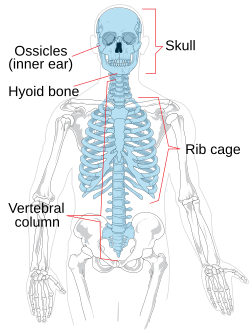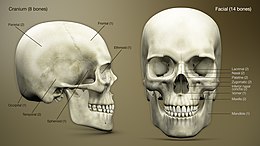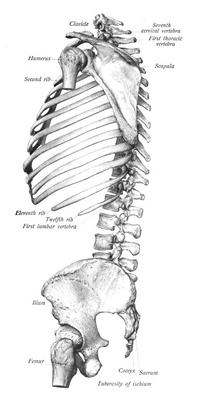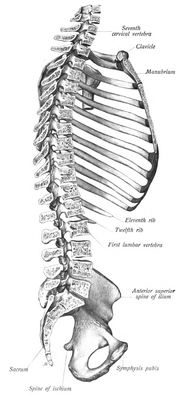Axial skeleton
| Axial skeleton | |
|---|---|
 Diagram of the axial skeleton | |
| Details | |
| Identifiers | |
| Latin | Skeleton axiale |
| TA98 | A02.0.00.009 |
| TA2 | 353 |
| Anatomical terminology | |

The axial skeleton is the part of the skeleton that consists of the bones of the head and trunk of a vertebrate. In the human skeleton, it consists of 80 bones and is composed of six parts; the skull (22 bones), also the ossicles of the middle ear, the hyoid bone, the rib cage, sternum and the vertebral column. The axial skeleton together with the appendicular skeleton form the complete skeleton. Another definition of axial skeleton is the bones including the vertebrae, sacrum, coccyx, ribs, and sternum.[1]
Structure
Flat bones house the brain and other vital organs. This article mainly deals with the axial skeletons of humans; however, it is important to understand the evolutionary lineage of the axial skeleton. The human axial skeleton consists of 81 different bones. It is the medial core of the body and connects the pelvis to the body, where the appendix skeleton attaches. As the skeleton grows older the bones get weaker with the exception of the skull. The skull remains strong to protect the brain from injury.
Human Skull
The human skull consists of the cranium and the facial bones. The cranium holds and protects the brain in a large space called the cranial vault. The cranium is formed from eight plate-shaped bones which fit together at meeting points (joints) called sutures. In addition there are 14 facial bones which form the lower front part of the skull. Together the 22 bones that compose the skull form additional, smaller spaces besides the cranial vault, such as the cavities for the eyes, the internal ear, the nose, and the mouth. The most important facial bones include the jaw or mandible, the upper jaw or maxilla, the zygomatic or cheek bone, and the nasal bone.[2]
Humans are born with separate plates which later fuse to allow flexibility as the skull passes through the pelvis and birth canal during birth. During development the eight separate plates of the immature bones fuse together into one single structure known as the Skull. The only bone that remains separate from the rest of the skull is the mandible.[3]
Rib cage
The rib cages are composed of 15 pairs of ribs plus the sternum for a total of 25 separate bones. The rib cage functions as protection for the vital organs such as the heart and lungs. The ribs are shaped like crescents, with one end flattened and the other end rounded. The rounded ends are attached at joints to the thoracic vertebrae at the back and the flattened ends come together at the sternum, in the front.[4]
The upper seven pairs of ribs attach to the sternum with costal cartilage and are known as “true ribs.” The 8th through 10th ribs have non-costal cartilage which connects them to the ribs above, and for this they are known as "false ribs". The last two ribs are called “floating ribs” because they do not attach to the sternum or to other ribs and simply “hang free.” The length of each rib increases from number one to seven and then decreases until rib pair number 12. The first rib is the shortest, broadest, flattest, and most curved.[5]
Vertebral column
At birth the majority of humans have 33 separate vertebrae. However, during normal development several vertebrae fuse together, leaving a total of 24, in most cases. The confusion about whether or not there are 32-34 vertebrae stems from the fact that the two lowest vertebrae, the sacrum and the coccyx, are single bones made up of several smaller bones which have fused together. This is how the vertebrae are counted: 24 separate vertebrae and the sacrum, formed from 5 fused vertebrae and the coccyx, formed from 4 fused vertebrae. If you count the coccyx and sacrum each as one vertebra, then there are 26 vertebrae. If the fused vertebrae are all counted separately, then the total number of vertebrae comes to between 32 and 34.
The vertebral column consists of 5 parts. The most cranial (uppermost) part is made up by the cervical vertebrae (7), followed by thoracic (12), lumbar (5), sacral (5) and coccygeal vertebrae (4).
Cervical vertebrae make up the junction between the vertebral column and the cranium. Sacral and coccygeal vertebras are fused and thus often called "sacral bone" or "ccoccygeal bone" as unit. The sacral bone makes up the junction between the vertebral column and the pelvic bones.
Etymology
The word "Axial" is taken from the word "axis" and refers to the fact that the bones are located close to or along the central "axis" of the body.The term axis means the central point around which the other structures are distributed. [6]
Short Summary
The axial skeleton consists of 80 bones:
- The skull, which contains 22 bones, from which 8 are cranial and 14 are facial,
- 6 middle ear ossicles (3 in each ear),
- 1 hyoid bone in the neck,
- 26 bones of vertebral column,
- 1 chest bone (sternum), and
- 24 ribs (12 pairs).
See also
References
- ^ Folkens, Tim D. White, Michael T. Black, Pieter A.; Pierter, Folkens; Michael, Black (2012). Human osteology (3rd ed.). Amsterdam: Elsevier/Academic Press. p. 11. ISBN 978-0-12-374134-9.
{{cite book}}: CS1 maint: multiple names: authors list (link) - ^ "Features of the Human Skull". Face and Emotion. Archived from the original on 14 February 2014. Retrieved 25 February 2014.
- ^ "Skull". Inner Body. Retrieved 25 February 2014.
- ^ "Postcranial Skeletal/Ribs" (PDF). Observation and Analysis Method for Human Bones. Archived from the original (PDF) on 20 May 2012. Retrieved 25 February 2014.
- ^ "Human Body Maps/Ribs". Healthtime. Retrieved 25 February 2014.
- ^ "Axial skeleton". AnatomyExpert. Archived from the original on 25 December 2013. Retrieved 15 March 2013.


